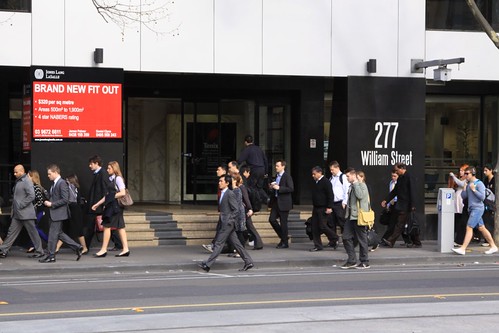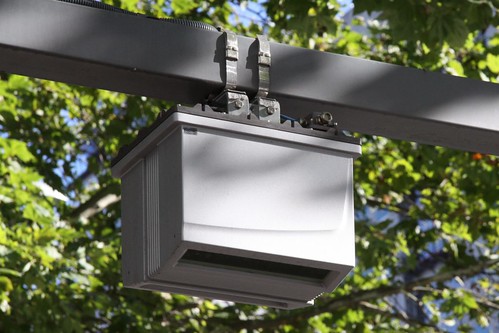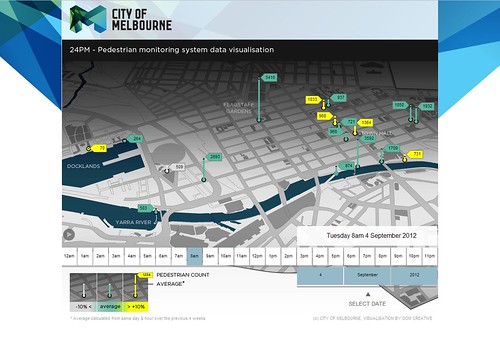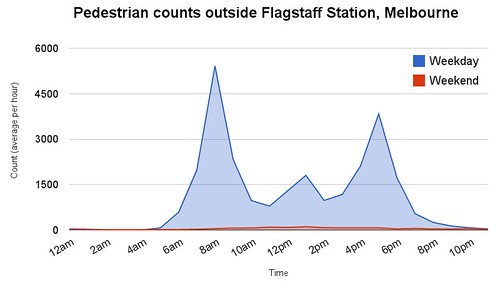Pedestrians – the City of Melbourne is full of them. But how do we know how many of them are pounding the footpaths each day? Posting people at street corners with a tally counter and a clipboard is one way, but now there is a much more high tech way to do the same job – can you see it?
If you can’t find it, it was hiding at the top left of the photo. Here is a closer look at it – this particular unit is located above the footpath on William Street, just south of the Flagstaff Station exit.
The above device is an electronic people counter, manufactured by an Australia company named Beonic. It works by creating two curtains of infra red laser light that scan the area beneath the sensor, counting the number of pedestrians passing beneath while avoiding false positives from items such as shopping trolleys and large suitcases. Data from the sensor is then fed back to a computer, where the data is logged and analysed.
Normally the result of the data analysis would fall into a black hole away from public view, but in the case of the City of Melbourne, they have decided to build a website to graphically present the information gathered by their network of 18 sensors located around the CBD. Called the ’24PM’ pedestrian monitoring system, you can find it at http://pedestrian.melbourne.vic.gov.au along with a set of FAQs.
From the website, you can drill down and see exactly how many people walk down a given street in Melbourne at a given time of day – the lead photo in this post was taken on September 4, 2012 at 8.55am and the screenshot above shows how many people walked past during that hour – 5416!
Here is a comparison of the average pedestrian count per hour registered outside Flagstaff station on two different days – ‘weekend’ data is from Saturday 1st September, 2012 while ‘weekday’ data is from Tuesday, 4th September 2012.
The variance in numbers illustrates how dead the western end of the Melbourne CBD can get – thousands of people flood the area during morning and afternoon peak on a weekday to access the station, but other times it is a ghost town. Traffic especially dies off on weekends, due to the closure of the adjacent Flagstaff Station.
All up there are 18 pedestrian counting points: six along Swanston Street, five along the Yarra River, four at Docklands, two near Parliament Station, and the one I found outside Flagstaff Station.
Want just the raw data? The City of Melbourne have also made it available in CSV format!
I can only imagine what other fun conclusions can be drawn from this data!
Sources
- Background of the City of Melbourne ’24PM’ pedestrian monitoring system
- How the laser sensors work
- Datasheet for the Beonic SNSSKE15 laser sensor pictured above.
Footnote
An article from today’s edition of The Age regarding a campaign by local traders – Push for Flagstaff to open 7 days.





Wow, it looks like the tinfoil hat guy was right.
The council does their best to allay those fears on their FAQ page:
Given the counters use a laser to detect people, their response is correct.
[…] More detailed information can be found here. […]
[…] detailed information can be found here. GA_googleFillSlot("Below_Post_Horizontal_Banner"); […]
[…] More detailed information can be found here. […]
[…] More detailed information can be found here. […]
[…] More detailed information can be found here. […]
[…] Wongm | V
Very cool. Well done to the city of Melbourne for publishing this.
Paul
They’ve definitely done a great job of it – just getting a government department to release CSV files of raw data is hard enough, but for them to build such a nice website to visualise it as well is amazing!
[…] More about how they did it here. […]
You should publish a correction: these are not manufactured by Beonic. They are made by an unrelated German company.
The pedestrian counter outside Flagstaff station has a ‘Beonic’ sticker on the side:
Also the device in the Beonic “Laser Sensor SNSSKE15” datasheet looks just like it:
http://www.oztecgroup.com.au/documents/trafficpro/Beonic_Laser_Sensor_SNSSKE15.pdf
Do you mean the actual hardware is rebadged equipment that was manufactured elsewhere? Or are the sensors at other locations different to the one I found?
Hi Marcus. I only know this sensor – from your photo – and I can definitely confirm that it is a SICK or PeCo laser sensor, made by that manufacturer (sorry, not sure of their real name).
It really is a sad fact of the international pedestrian counting industry that ALL suppliers act as if they are the creators of the counters. Manufacturers should control this.
Absolutely: Beonic do not manufacture any counter. All counters suited for serious counting work come from three major manufacturers around the world, providing three different counting technologies.
Do you work for the CoM?
A 🙂
Looking at the two websites, the “LD 3100” unit from LASE PeCo GmbH matches the one Beonic sells:
http://www.peoplecounter.de/en/hardware/people-counting/peco-ld-3100.html
I would have thought that in the world of expensive electronic hardware with big R&D costs, that the original manufacturer would sign up distributors around the world to sell for them, not allowing them to rebrand devices as their own product.
And no, I don’t work for the CoM – just an observant pedestrian.
For Melbourne, would Mashalite style counters seem appropriate?
Clever!
https://en.wikipedia.org/wiki/Marshalite
Pneumatic sensors are another old idea – the corner of Little Collins and Queen Street in the Melbourne CBD still has the remnants of such equipment.
No, that’s not what I mean, I mean counters that display a clock face, this could be done with LEDs.